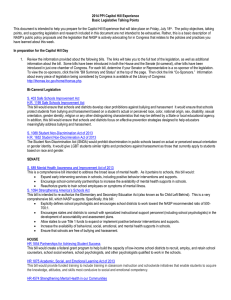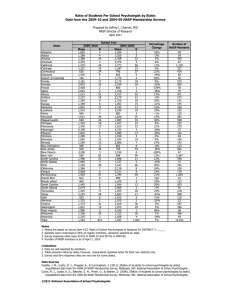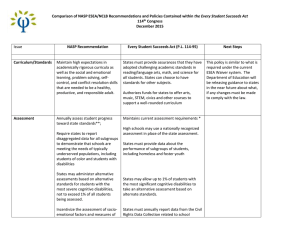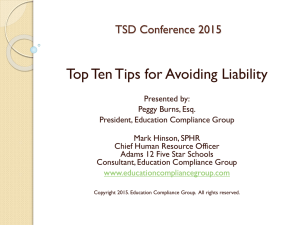2015 PPI Capitol Hill Experience Basic Legislative Talking Points
advertisement
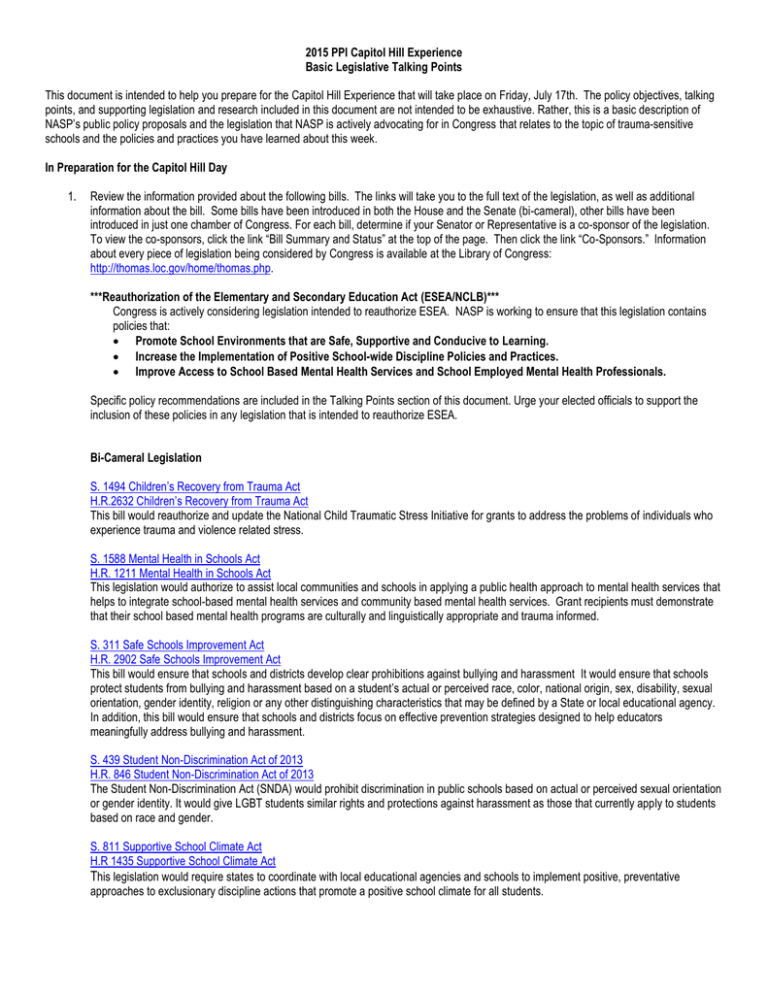
2015 PPI Capitol Hill Experience Basic Legislative Talking Points This document is intended to help you prepare for the Capitol Hill Experience that will take place on Friday, July 17th. The policy objectives, talking points, and supporting legislation and research included in this document are not intended to be exhaustive. Rather, this is a basic description of NASP’s public policy proposals and the legislation that NASP is actively advocating for in Congress that relates to the topic of trauma-sensitive schools and the policies and practices you have learned about this week. In Preparation for the Capitol Hill Day 1. Review the information provided about the following bills. The links will take you to the full text of the legislation, as well as additional information about the bill. Some bills have been introduced in both the House and the Senate (bi-cameral), other bills have been introduced in just one chamber of Congress. For each bill, determine if your Senator or Representative is a co-sponsor of the legislation. To view the co-sponsors, click the link “Bill Summary and Status” at the top of the page. Then click the link “Co-Sponsors.” Information about every piece of legislation being considered by Congress is available at the Library of Congress: http://thomas.loc.gov/home/thomas.php. ***Reauthorization of the Elementary and Secondary Education Act (ESEA/NCLB)*** Congress is actively considering legislation intended to reauthorize ESEA. NASP is working to ensure that this legislation contains policies that: Promote School Environments that are Safe, Supportive and Conducive to Learning. Increase the Implementation of Positive School-wide Discipline Policies and Practices. Improve Access to School Based Mental Health Services and School Employed Mental Health Professionals. Specific policy recommendations are included in the Talking Points section of this document. Urge your elected officials to support the inclusion of these policies in any legislation that is intended to reauthorize ESEA. Bi-Cameral Legislation S. 1494 Children’s Recovery from Trauma Act H.R.2632 Children’s Recovery from Trauma Act This bill would reauthorize and update the National Child Traumatic Stress Initiative for grants to address the problems of individuals who experience trauma and violence related stress. S. 1588 Mental Health in Schools Act H.R. 1211 Mental Health in Schools Act This legislation would authorize to assist local communities and schools in applying a public health approach to mental health services that helps to integrate school-based mental health services and community based mental health services. Grant recipients must demonstrate that their school based mental health programs are culturally and linguistically appropriate and trauma informed. S. 311 Safe Schools Improvement Act H.R. 2902 Safe Schools Improvement Act This bill would ensure that schools and districts develop clear prohibitions against bullying and harassment It would ensure that schools protect students from bullying and harassment based on a student’s actual or perceived race, color, national origin, sex, disability, sexual orientation, gender identity, religion or any other distinguishing characteristics that may be defined by a State or local educational agency. In addition, this bill would ensure that schools and districts focus on effective prevention strategies designed to help educators meaningfully address bullying and harassment. S. 439 Student Non-Discrimination Act of 2013 H.R. 846 Student Non-Discrimination Act of 2013 The Student Non-Discrimination Act (SNDA) would prohibit discrimination in public schools based on actual or perceived sexual orientation or gender identity. It would give LGBT students similar rights and protections against harassment as those that currently apply to students based on race and gender. S. 811 Supportive School Climate Act H.R 1435 Supportive School Climate Act This legislation would require states to coordinate with local educational agencies and schools to implement positive, preventative approaches to exclusionary discipline actions that promote a positive school climate for all students. SENATE S. 897 Jesse Lewis Empowering Educators Act Amends Title II of the Elementary and Secondary Education Act of 1965 to include teacher and principal training in practices that address the social and emotional development needs of students among the activities funded under the Teacher and Principal Training and Recruiting Fund program. These activities include training in classroom instruction and school-wide initiatives that enable students to acquire the knowledge, attitudes, and skills most conducive to social and emotional competency HOUSE HR 850 Academic, Social, and Emotional Learning Act of 2015 Amends Title II of the Elementary and Secondary Education Act of 1965 to include teacher and principal training in practices that address the social and emotional development needs of students among the activities funded under the Teacher and Principal Training and Recruiting Fund program. These activities include training in classroom instruction and school-wide initiatives that enable students to acquire the knowledge, attitudes, and skills most conducive to social and emotional competency. 2. For each bill, see if your Senator/Representatives has signed on. If your elected official IS a sponsor, thank them for their support of this bill if it comes up in conversation. If they are not, encourage them to consider co-sponsoring this legislation, or supporting it when it is called for a vote. 3. Don’t worry about understanding the fine details of each bill. Instead focus on 2 main points: How does the bill propose to address a specific issue? Why is such a policy needed and what are the consequences of not addressing the issue. If you would like more specific information about a piece of legislation, or a public policy concern prior to the Capitol Hill Experience, contact Kelly Vaillancourt Strobach, NASP Director of Government Relations (kvaillancourt@naspweb.org). Most of the time your conversations will be more about broad issues, not specific details regarding legislation. Following each policy objective and subsequent talking points specific pieces of legislation that are intended to address the policy objective are listed. During your visits you may choose to discuss as few or as many policy objectives/proposed bills as you choose. You may also choose to talk about the broad policy proposal and not specific legislation. NASP’s public policy agenda is grounded by empirical research. It is not necessary to cite specific research in your meetings, as this information Is included in the Hill packets you will leave behind. Research that supports the NASP policy agenda can be found in the NASP Research Center. Contact Kelly Vaillancourt Strobach (kvaillancourt@naspweb.org), NASP Director of Government Relations, with any questions. 4. 5. 6. Setting the Stage for Advocacy: The Basics o o o o o o o o o o If you have business cards, bring them with you so that you may leave your contact information behind. Thank the legislative assistant/Congressman/Senator for taking the time to visit with you. Introduce yourself and each person in your group and provide a brief statement about yourself and your experience in school psychology. Be sure to identify yourselves as constituents. Offer some basic information about role of school psychologists and the importance of our work in supporting school and student success and creating trauma sensitive schools. Feel free to share relevant anecdotal comments throughout the meeting. Focus on the comprehensive role of a school psychologist including, prevention, intervention, and consultation services with school staff and families. There is information in their packet that explains what a school psychologist does and how we coordinate with others to provide comprehensive learning supports that help students achieve their best. Emphasize the need for all school-employed mental health professionals in schools: school psychologists, school counselors, and school social workers. The needs of students and families are best met when we work collaboratively together. Be sure to mention the importance of collaboration among teachers, administrators, parents, families, and communities in addressing the needs of children and youth. If there is a specific policy that is working well (or is not working well) in your state or district, share information about it. Members of Congress are highly interested in what is happening in their home state. Don’t worry if you are asked a question that you do not know the answer to. Do not give false information, rather let them know you will follow up with them. If you need assistance with finding the requested information, contact Kelly Vaillancourt Strobach (kvaillancourt@naspweb.org). Key Talking Points: School psychologists, in collaboration with other school and community professionals, play a critical role in creating safe, supportive, traumasensitive learning environments that promote student learning. A strong system of comprehensive learning supports is equally as important as effective teaching in helping students achieve and exceed their academic potential. Access to behavioral, social-emotional, and mental supports promotes student resilience, improves academic performance, and allows children and youth to successfully deal with challenges they may face. Unfortunately, non-academic learning, behavioral, emotional, and mental health supports are given marginal attention and too often, students struggle in meeting their academic potential, or fail to complete school due to the lack of access to these critical services There are three broad policy goals that help promote trauma-sensitive schools where all students feel physically and emotionally safe at school and have access to the supports they need to reach their fullest potential: Promote School Environments that are Safe, Supportive and Conducive to Learning. Increase the Implementation of Positive School-wide Discipline Policies and Practices. Improve Access to School Based Mental Health Services and School Employed Mental Health Professionals. Promote School Environments that are Safe, Supportive, and Conducive to Learning. Supportive school environments that promote school connectedness, prevent negative behaviors, and proactively teach and reinforce positive behaviors and social skills create an atmosphere where students thrive. These environments also help to prevent bullying and harassment and improve school climate. Safe and supportive environments are necessary for student success. 1) 2) 3) 4) 5) Ways to address this policy issue: Encourage school districts to implement school wide programs, problem -solving processes, and prevention and intervention services embedded in multi-tiered systems of support. Provide funds to train teachers and school staff in classroom instruction and school-wide initiatives that enable students to acquire knowledge, attitudes, and skills conducive to social and emotional competency. Require schools to adopt and implement policies that specifically prohibit bullying, harassment, and discrimination based on a student’s actual or perceived race, color, national origin, sex, disability, sexual orientation, gender identity, gender expression, or religion. Encourage policies that help schools and school districts implement evidence based school wide bullying prevention programs, including professional development on how to identify and respond to incidents of bullying. Encourage schools and districts to adopt restorative justice practices and/or other methods of teaching students effective conflict resolution skills. Supporting Research Changing a school’s climate and connectedness for the better is associated with significant increases in reading, writing, and math, regardless of whether a school starts with high or low school climate and connectedness or high or low achievement scores (Spier et al., 2007; Spier et al., 2007) Interventions that strengthen students’ social, emotional, and decision-making skills also positively impact their academic achievement both in terms of higher standardized test scores and better grades (Fleming et al., 2005). Interventions that foster strong and supportive relationships with teachers help students to feel more safe and secure in school, feel more competent, make more positive connections with peers, and achieve greater academic success (Hamre & Pianta, 2006). Whole school interventions using positive behavior support have been shown to decrease behavior problems while improving academic performance, as measured by standardized tests in reading and math (Luisilli, et al., 2005; Waasadorp, Bradshaw, & Leaf, 2012). Proposed Legislation SENATE S. 311 Safe Schools Improvement Act S. 897 Jesse Lewis Empowering Educators Act S. 439 Student Non-Discrimination Act of 2013 HOUSE H.R. 2902 Safe Schools Improvement Act HR 850 Academic, Social, and Emotional Learning Act of 2015 H.R. 846 Student Non-Discrimination Act of 2013 Increase the Implementation of Positive Schoolwide Discipline Policies and Practices. Schools must have discipline policies and practices that are positive, fair, consistently implemented, and are designed to keep students in the classroom. To stop the school to prison pipeline and keep youth in school, ineffective and harmful zero tolerance policies need to be replaced with positive discipline practices. 1) 2) 3) 4) Ways to address this policy issue: Prohibit the use of zero tolerance policies in schools except in cases that directly violate the Gun Free Schools Act. Increase the implementation of initiatives such as positive behavioral interventions and supports and/or restorative justice to keep students in school out of the juvenile justice system. Encourage schools to allow students to have input on the behavioral and discipline practices and policies. Increase collaboration between the school, law enforcement, juvenile justice, social services, and families. Supporting Research Zero tolerance policies strengthen the link between schools and prisons, and they negatively impact a disproportionately large number of minority students (Casella, 2003; APA, 2004). Effective discipline policies are important in helping to counteract the effects of trauma. Such policies and practices include engaging students in efforts to improve discipline policy, using restitution, and ensuring students continue to receive quality instruction when they are removed from the classroom for disciplinary reasons (Ristuccia, 2013; Morgan, Salomon, Plotkin, & Cohen, 2014). Empirical evidence has not shown zero tolerance policies to be effective in reducing violence or promoting learning. In fact, they can inhibit academic achievement and increase problem behaviors and dropout rates among middle and secondary school students (Skiba, 2004; APA 2008). Suspension and expulsion are often administered unfairly and they increase the likelihood of students’ poor academic performance and dropping out of school, while having no measurable deterrent effect or academic benefit. Even worse, there is a direct link between suspension and expulsion and the likelihood of being sentenced to prison (Mendez, 2003; Fenning & Rose, 2007; Maag, 2012). Proposed Legislation SENATE S. 811 Supportive School Climate Act HOUSE H.R 1435 Supportive School Climate Act Improve Access to School Based Mental Health Services , School Employed Mental Health Professionals, and Community Based Services. Comprehensive and coordinated learning and mental health supports directly contribute to more positive student outcomes and increased academic achievement. School employed mental health professionals, such as school psychologists, have unique training that allows them to deliver these services within the context of learning, and in support of the mission of schools. These professionals can provide critical early identification and early intervention services to help students build the skills they need to meet the academic and social demands of school and life. Policies, as well as funding, that improve student access to these professionals and services can help ensure that all students needs are identified and met. 1) 2) 3) Ways to address this policy issue: Provide sufficient student support services and access to qualified school employed mental health to meet the needs of students, improve student resilience, and promote healthy learning and development by coordinating services across a continuum of care that integrates schools, families, and community providers. Encourage schools and districts to work toward the NASP recommended ratio of 500-700 school psychologists to 1 student. Encourage policies that establish programs fostering supportive relationships between students in transition and caring adults (e.g., mentoring, educational liaisons, educational advocates, specific program coordinators). Supporting Research The impact of promotion and prevention interventions is at least two to three times higher when programs are carefully implemented by qualified personnel who have expert knowledge of the relevant issues being addressed (Durlak & Dupre, 2008). Empirical evidence demonstrates that services provided by school psychologists can have a significant, positive impact on students’ academic achievement (Goodman & Young, 2006). School counseling practices have been shown to improve students’ social skills, and school social work services have been shown to be cost-effective in reducing problem behaviors and school exclusion ( Whiston & Sexton, 1998; Bagley & Pritchard, 1998). Proposed Legislation SENATE S. 1588 Mental Health in Schools Act S. 1494 Children’s Recovery from Trauma Act HOUSE H.R. 1211 Mental Health in Schools Act H.R.2632 Children’s Recovery from Trauma Act CLOSING: 1. Ask if the legislative assistant/elected official has any questions. 2. Ask what their general perception of these proposals and requests are and if they think that their boss can support these issues. 3. Offer to provide future input if needed. (Follow up as requested.) 4. Thank them for their time and attention to your issues.
